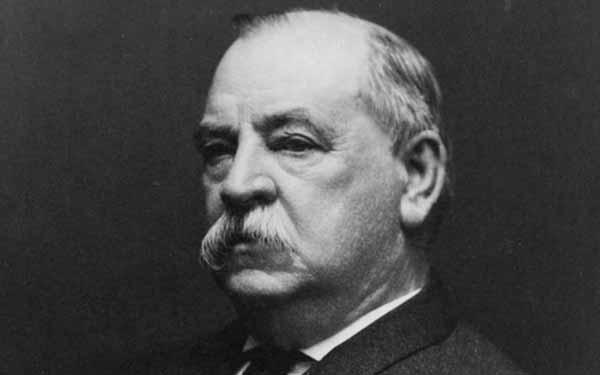Grover Cleveland is the only U.S. President to have served two non-consecutive terms of office, 1885-1889 and 1893-1897.
Stephen Grover Cleveland had a meteoric ascent to the nation’s highest office. In 1881 he held the comparatively minor post as mayor of Buffalo, New York. The next year he became Governor of New York and just two years after that was President of the United States.
Early Year
Stephen Grover Cleveland was born in Caldwell, New Jersey on March 18, 1837. His father was a poor but highly educated minister. The family moved to New York State where his father died when Cleveland was sixteen years old.
Hopes of college were out for the young Cleveland, who had to help support his family. He worked with an older brother in New York City before obtaining a position in Buffalo as a part time law clerk and student. Without formal training Cleveland passed the New York state bar in 1859 at the age of twenty-two.
Civil War
Unlike many of his contemporaries, Cleveland avoided military ser by paying a bounty for a replacement. Years later his political enemies would point this out. He was at this point considered a hardworking and honest lawyer.
Political Career
Cleveland was elected sheriff of Erie County in 1870 and would serve for three years before returning to his private law practice. Although a Democrat, he did not engage in partisan politics. Therefore, he was surprised when he was asked to run for mayor of Buffalo by the local Democratic committee in 1880. He won in what was considered an upset victory.
Within a year as mayor, state Democratic Party leaders were taking note of the new man on the political scene. He had vetoed extravagant appropriations, exposed graft and corruption in city government, and required hard work and efficiency from city employees. He was asked to run for the position of governor.
Campaign and Election of 1884
After two years as Governor of New York, Cleveland had been noticed by national Democratic Party leaders. Cleveland was respected in his home state. Party leaders recognized that the key to taking the White House away from the Republicans, who had held it since the time of Lincoln, might lie in capturing New York State along with what was now become the solid Democratic South.
The strategy worked although Cleveland’s margin of victory over James Blaine of Maine was just over 1,000 votes in New York, it was enough to elect him president.
Cleveland’s First Term
Cleveland’s first term of office was marked by little initiative in legislation being initiated by the White House. The reason is quite simple; he was the first Democrat to be elected president since James Buchanan in 1856. His interests were to prevent the Republicans from conducting “business as usual” during his term of office.
He did this most effectively with his use of the veto. In fact, he vetoed more bills than all of the president’s combined from George Washington until his election had done.
Campaign and Election of 1888
Many would have thought that the election of 1884 was so close the election of 1888 would be a rematch of Cleveland against Blaine. This was not the case, as Blaine, believing a united Republican front would be necessary to defeat Cleveland, withdrew from the race before the Republican convention.
The Republicans nominated Benjamin Harrison in the hope that he would carry Indiana, his home state, which had gone to Cleveland in the previous election.
The strategy worked and Harrison was elected even though he lost in the popular vote by 90,000.
Campaign and Election 1892
In this case it was a rematch of Harrison versus Cleveland. The deciding factor in the elections was tariffs which put Harrison at a disadvantage. Cleveland this time took the swing states of New York and Indian and had a more comfortable popular margin of approximately 380,000 votes.
Cleveland’s Second Term
Early into his second term the Panic of 1893 hit the financial markets which threw the country into a severe economic recession.
Cleveland was able to partially undo the changes to the tariffs and saw the repeal of the McKinley tariff.
In foreign affairs the notion of annexing Hawaii was somewhat resolved in a compromise in that United States did not annex the islands but recognized a new provisional government.
Labor unrest and violence was widespread as the country was still working out issues of child labor, length of a workday, and unionization.








